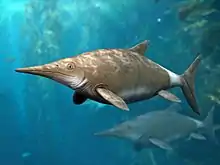Brachypterygius
Brachypterygius (meaning ″wide wing/paddle″ in Greek) is an extinct genus of platypterygiine ophthalmosaurid ichthyosaur known from the Late Jurassic of England.[1] The type species was originally described and named as Ichthyosaurus extremus by Boulenger in 1904.[2] Brachypterygius was named by Huene in 1922 for the width and shortness of the forepaddle, and the type species is therefore Brachypterygius extremus.[3] The holotype of B. extremus was originally thought to be from the Lias Group of Bath, United Kingdom, but other specimens suggest it more likely came from the Kimmeridgian Kimmeridge Clay (Late Jurassic) of Kimmeridge Bay, Dorset, UK.
| Brachypterygius | |
|---|---|
 | |
| Restoration | |
| Scientific classification | |
| Kingdom: | Animalia |
| Phylum: | Chordata |
| Class: | Reptilia |
| Order: | †Ichthyosauria |
| Family: | †Ophthalmosauridae |
| Subfamily: | †Platypterygiinae |
| Genus: | †Brachypterygius von Huene, 1922 |
| Species | |
| |
Description
Brachypterygius is a medium to large ichthyosaur, with a skull length of 0.5–1.2 m.[4][5] The snout is long, as is characteristic for ichthyosaurs, with larger and more robust teeth, and a relatively smaller eye than Ophthalmosaurus.[5] The basioccipital has a very narrow extracondylar area.[5] The forepaddle may have five or six digits, with the maximum phalangeal count being between 8 and 16.[2][5] A key feature is the three facets at the distal end of the humerus; the middle is the smallest and articulates with the intermedium, which clearly separates Brachypterygius from Ophthalmosaurus, the most common Late Jurassic ichthyosaur.[2]
Taxonomy
The holotype of Brachypterygius extremus is a single right forepaddle, clearly different from other Late Jurassic ichthyosaurs (e.g. Ophthalmosaurus).[2] A large skull was discovered in the Kimmeridge Clay of Stowbridge, Norfolk, UK and named as a new genus and species, Grendelius mordax, by McGowan in 1976.[4] More complete material from the Kimmeridge Clay of Kimmeridge Bay united these two specimens and the two genera were duly synonymised.[5] In 2003, McGowan & Motani synonymised the two species B. extremus and B. mordax into B. extremus, considering differences in the forepaddle to be of insufficient taxonomic value.[1]
Brachypterygius is closely related to Platypterygius and Caypullisaurus.[6]
Previously referred to Brachypterygius
Owen (1840) erected Ichthyosaurus trigonus based upon a single dorsal vertebra (ANSP 10124) from the Kimmeridge Clay of Westbrook, Wiltshire, UK.[7] The holotype was long thought to be lost until it was rediscovered in 1988.[8] Many specimens were referred to Ichthyosaurus trigonus; Bauer (1898) suggested that – what are now – Ophthalmosaurus, Brachypterygius and Nannopterygius should be synonymised into Ichthyosaurus trigonus.[9] I. trigonus was included in the new genus Macropterygius by Huene (1922),[10] who later (1923) made it the type species of the genus.[11] Nowadays, I. trigonus (and hence Macropterygius) is a nomen dubium because its holotype is indistinguishable from other ophthalmosaurids.[12] (McGowan and Motani mistakenly stated that I. trigonus may be synonymous with Ophthalmosaurus icenicus[1])
Richard Lydekker erected the species Ophthalmosaurus cantabridgiensis from the Cambridge Greensand (Albian, Early Cretaceous) of Cambridge, UK, on the basis of a humerus (NHMUK 43989).[13] McGowan and Motani (2003) considered it to be a species of Brachypterygius,[1] but a recent re-assessment of Cambridge Greensand ichthyosaurs found it to be a nomen dubium indeterminate beyond Ophthalmosaurinae.[14]
References
- McGowan, C. & Motani, R. Ichthyopterygia. In Sues, H.-D. (ed.) Handbook of Paleoherpetology, vol. 8. Verlag Dr. Friedrich Pfeil, Munich, 175 pp., 19 pls.
- Boulenger, G. A. 1904. Exhibition of, and remarks upon, a paddle of a new species of ichthyosaur. Proceedings of the Zoological Society of London, 1904, 424–426.
- Huene, F. F. von 1922. Die Ichthyosaurier des Lias und ihre Zusammenhänge. Verlag von Gebrüder Borntraeger, Berlin, 114 pp., 22 pls.
- McGowan, C. 1976. The description and phenetic relationships of a new ichthyosaur genus from the Upper Jurassic of England. Canadian Journal of Earth Sciences, 13, 668–683. doi:10.1139/e76-070
- McGowan, C. 1997. The taxonomic status of Grendelius mordax: a preliminary report. Journal of Vertebrate Paleontology, 17, 428–430. doi:10.1080/02724634.1997.10010986
- Fernández M. 2007. Redescription and phylogenetic position of Caypullisaurus (Ichthyosauria: Ophthalmosauridae). Journal of Paleontology 81 (2): 368-375.
- Owen, R. 1840. Report on British Fossil Reptiles. Part I. Report of the British Association for the Advancement of Science, 9, 43–126.
- Spamer, E.E., Bogan, A.E. & Torrens, H.S. 1989. Recovery of the Etheldred Benett collection offossils mostly from Jurassic-Cretaceous strata of Wiltshire, England, analysis of the taxonomic nomenclature of Benett (1831), and notes and figures of type specimens contained in the collection. Proceedings of the Academy of Natural Sciences of Philadelphia, 141:115-180.
- Bauer, F. 1898. Die Ichthyosaurier des oberen weissen Jura. Palaeontographica, 44, 283–328.
- Huene, F. von. 1922. Die Ichthyosaurier des Lias und ihre Zusammenhange. Monographien zur Geologic and Palaeontologie, 1: 1-114.
- Huene, F. von. 1923. Lines of phyletic and biological development of the Ichthyopterygia. Bulletin of the Geological Society of America, 34: 463-468.
- Bardet N, Fernández M. 2000. A new ichthyosaur from the Upper Jurassic lithographic limestones of Bavaria.Journal of Paleontology 74 (3): 503-511.
- Lydekker, R. 1888. Note on the classification of the Ichthyopterygia (with a notice of two new species). Geological Magazine, 5, 309–313. doi:10.1017/S0016756800181968
- Fischer, V.; Bardet, N.; Guiomar, M.; Godefroit, P. (2014). "High Diversity in Cretaceous Ichthyosaurs from Europe Prior to Their Extinction". In Farke, Andrew A. PLoS ONE 9: e84709. doi:10.1371/journal.pone.0084709. edit




